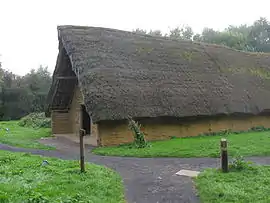Balbridie
Balbridie is the site of a Neolithic long house in Aberdeenshire, Scotland, situated on the south bank of the River Dee, east of Banchory.[1] The site is one of the earliest known permanent Neolithic settlements in Scotland, dating from 3400—4000 BC. This is the largest Neolithic long house to be excavated in Britain.[1][2][3] In a European context, Whittle has indicated the rarity of such large Neolithic timber houses, citing Balbridie, a hall in Cambridgeshire, and Fengate as a small set of such finds.[4]
 Reconstruction of a Neolithic long house of the type discovered at Balbridie | |
| Location | Banchory, Aberdeenshire |
|---|---|
| Coordinates | 57.05356°N 2.44325°W |
| Type | Neolithic long house |
| Length | 26 m (85 ft) |
| Width | 13 m (43 ft) |
| Area | 329.6 m2 (3,548 sq ft) |
| History | |
| Founded | Early to mid 4th millennium BC |
| Periods | Neolithic |
| Site notes | |
| Excavation dates | 1977-1980 |
| Archaeologists | Nicholas Reynolds and Ian Ralston |
| Condition | No extant remains |
| Ownership | Historic Scotland |
| Management | RCAHMS |
| Public access | Yes |
| Designated | 1978 |
| Reference no. | (CANMORE) 36669 |
Neolithic features found in a later excavation at Dreghorn included post holes indicating a large rectangular structure comparable to Balbridie.[5]
Discovery
The Balbridie site was discovered in 1976 by aerial photography carried out by the Royal Commission on the Ancient and Historical Monuments of Scotland. The unusually dry summer revealed previously undetected cropmarks suggesting a very large structure.[6] Subsequent archaeological work on site allowed the conceptual reconstruction of an enormous timber structure including the identification of large timber postholes.
Relationship to other very early features
The vicinity of Balbridie includes a number of other notable archaeological features including the Neolithic site of Bucharn. Watt has pointed out that this local area attracted an unusual density of very early settlement in Scotland. Balbridie is not only close to the River Dee but also to the Elsick Mounth trackway, the route of early crossings inland through the lower Grampian Mountains.
See also
References
- Notes
- Fairweather & Ralston 1993.
- Bellwood 2004.
- Barclay 1998, p. 15.
- Whittle 1996.
- "Dreghorn, Station Brae". Canmore. Retrieved 22 February 2016.
- Ralston, Ian; Reynolds, Nicholas (27 May 1978). "Balbridie: Early architectural site". The Times. London. p. 3.
- Bibliography
- Barclay, Gordon (1998). Farmers, Temples and Tombs: Scotland in the Neolithic and Early Bronze Age. Edinburgh: Canongate Books. ISBN 978-0-862-41821-2.CS1 maint: ref=harv (link)
- Bellwood, Peter S. (2004). First Farmers: The Origins of Agricultural Societies. Oxford: Wiley-Blackwell. ISBN 978-0-631-20566-1.CS1 maint: ref=harv (link)
- Fairweather, Alan D.; Ralston, Ian B.M. (1993). "The Neolithic Timber Hall at Balbridie". Antiquity (67): 313–323.CS1 maint: ref=harv (link)
- Whittle, Alasdair (1996). Europe in the Neolithic: The Creation of New Worlds. Cambridge: Cambridge University Press. ISBN 978-0-521-44920-5.CS1 maint: ref=harv (link)
